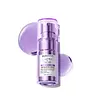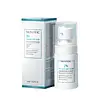What's inside
What's inside
 Key Ingredients
Key Ingredients

 Benefits
Benefits

 Concerns
Concerns

No concerns
 Ingredients Side-by-side
Ingredients Side-by-side

Water
Skin ConditioningGlycerin
HumectantLactic Acid
BufferingButylene Glycol
HumectantGluconolactone
Skin ConditioningPropylene Glycol
HumectantPropanediol
SolventSodium Hydroxide
BufferingAlbizia Julibrissin Bark Extract
MaskingSuccinic Acid
BufferingHydrolyzed Collagen
EmollientEnantia Chlorantha Bark Extract
Skin ConditioningCitrus Paradisi Fruit Extract
Skin ConditioningXanthan Gum
EmulsifyingHydroxyacetophenone
AntioxidantSalicylic Acid
MaskingLactobionic Acid
BufferingMandelic Acid
AntimicrobialHydroxycinnamic Acid
Skin ConditioningRutin
AntioxidantGlycerophosphoinositol Choline
Skin ProtectingNiacinamide
SmoothingAlpha-Arbutin
Antioxidant1,2-Hexanediol
Skin ConditioningPEG-40 Hydrogenated Castor Oil
EmulsifyingAcrylamide/Sodium Acryloyldimethyltaurate Copolymer
Emulsion StabilisingAmmonium Sulfate
Sodium Sulfate
Citric Acid
BufferingAmylopectin
Ethylhexylglycerin
Skin ConditioningOleanolic Acid
Skin ConditioningDextrin
AbsorbentPhenoxyethanol
PreservativeSodium Benzoate
MaskingAroma
CI 16035
Cosmetic ColorantCI 60730
Cosmetic ColorantWater, Glycerin, Lactic Acid, Butylene Glycol, Gluconolactone, Propylene Glycol, Propanediol, Sodium Hydroxide, Albizia Julibrissin Bark Extract, Succinic Acid, Hydrolyzed Collagen, Enantia Chlorantha Bark Extract, Citrus Paradisi Fruit Extract, Xanthan Gum, Hydroxyacetophenone, Salicylic Acid, Lactobionic Acid, Mandelic Acid, Hydroxycinnamic Acid, Rutin, Glycerophosphoinositol Choline, Niacinamide, Alpha-Arbutin, 1,2-Hexanediol, PEG-40 Hydrogenated Castor Oil, Acrylamide/Sodium Acryloyldimethyltaurate Copolymer, Ammonium Sulfate, Sodium Sulfate, Citric Acid, Amylopectin, Ethylhexylglycerin, Oleanolic Acid, Dextrin, Phenoxyethanol, Sodium Benzoate, Aroma, CI 16035, CI 60730
Water
Skin ConditioningButylene Glycol
HumectantPentylene Glycol
Skin ConditioningBetaine
HumectantTranexamic Acid
AstringentNiacinamide
SmoothingAlpha-Arbutin
AntioxidantIsononyl Isononanoate
EmollientCyclopentasiloxane
EmollientPEG-32
HumectantCyclohexasiloxane
EmollientDimethicone/PEG-10/15 Crosspolymer
Ectoin
Skin ConditioningHydroxyethylpiperazine Ethane Sulfonic Acid
BufferingAllantoin
Skin ConditioningCentella Asiatica Extract
CleansingSodium Hyaluronate
HumectantBis-PEG/PPG-20/5 PEG/PPG-20/5 Dimethicone
EmulsifyingMethoxy PEG/PPG-25/4 Dimethicone
EmulsifyingSoy Amino Acids
Skin ConditioningAcetyl Glucosamine
Skin ConditioningCeramide EOP
Skin ConditioningCeramide Ns
Skin ConditioningCeramide NP
Skin ConditioningCeramide AP
Skin ConditioningGlycyrrhiza Glabra Root Extract
BleachingCeramide As
Skin ConditioningArginine
MaskingGalactomyces Ferment Filtrate
HumectantDecarboxy Carnosine Hcl
Skin ConditioningHydrolyzed Sodium Hyaluronate
Skin ConditioningTocopherol
AntioxidantErgothioneine
AntioxidantNonapeptide-1
Skin ConditioningOligopeptide-1
Skin ConditioningHexapeptide-2
BleachingHexapeptide-9
Skin ConditioningSodium Acetylated Hyaluronate
HumectantSodium Hyaluronate Crosspolymer
HumectantCitrus Reticulata Fruit Extract
Skin ProtectingCarbenia Benedicta Extract
Skin ConditioningHydrogenated Lecithin
EmulsifyingPalmitoyl Tripeptide-1
Skin ConditioningPalmitoyl Tetrapeptide-7
Skin ConditioningGlyceryl Stearate
EmollientSodium Polyglutamate
HumectantPolyacrylate Crosspolymer-6
Emulsion StabilisingEthylhexylglycerin
Skin ConditioningHydroxyphenyl Propamidobenzoic Acid
Skin ConditioningDipropylene Glycol
HumectantSodium Citrate
BufferingCetyl-Pg Hydroxyethyl Palmitamide
Skin ConditioningCarbomer
Emulsion StabilisingCholesterol
EmollientGlycerin
Humectant1,2-Hexanediol
Skin ConditioningPropanediol
SolventPotassium Sorbate
PreservativePhenoxyethanol
PreservativeSodium Lactate
BufferingPolysorbate 20
EmulsifyingWater, Butylene Glycol, Pentylene Glycol, Betaine, Tranexamic Acid, Niacinamide, Alpha-Arbutin, Isononyl Isononanoate, Cyclopentasiloxane, PEG-32, Cyclohexasiloxane, Dimethicone/PEG-10/15 Crosspolymer, Ectoin, Hydroxyethylpiperazine Ethane Sulfonic Acid, Allantoin, Centella Asiatica Extract, Sodium Hyaluronate, Bis-PEG/PPG-20/5 PEG/PPG-20/5 Dimethicone, Methoxy PEG/PPG-25/4 Dimethicone, Soy Amino Acids, Acetyl Glucosamine, Ceramide EOP, Ceramide Ns, Ceramide NP, Ceramide AP, Glycyrrhiza Glabra Root Extract, Ceramide As, Arginine, Galactomyces Ferment Filtrate, Decarboxy Carnosine Hcl, Hydrolyzed Sodium Hyaluronate, Tocopherol, Ergothioneine, Nonapeptide-1, Oligopeptide-1, Hexapeptide-2, Hexapeptide-9, Sodium Acetylated Hyaluronate, Sodium Hyaluronate Crosspolymer, Citrus Reticulata Fruit Extract, Carbenia Benedicta Extract, Hydrogenated Lecithin, Palmitoyl Tripeptide-1, Palmitoyl Tetrapeptide-7, Glyceryl Stearate, Sodium Polyglutamate, Polyacrylate Crosspolymer-6, Ethylhexylglycerin, Hydroxyphenyl Propamidobenzoic Acid, Dipropylene Glycol, Sodium Citrate, Cetyl-Pg Hydroxyethyl Palmitamide, Carbomer, Cholesterol, Glycerin, 1,2-Hexanediol, Propanediol, Potassium Sorbate, Phenoxyethanol, Sodium Lactate, Polysorbate 20
Ingredients Explained
These ingredients are found in both products.
Ingredients higher up in an ingredient list are typically present in a larger amount.
1,2-Hexanediol is a synthetic liquid and another multi-functional powerhouse.
It is a:
- Humectant, drawing moisture into the skin
- Emollient, helping to soften skin
- Solvent, dispersing and stabilizing formulas
- Preservative booster, enhancing the antimicrobial activity of other preservatives
Alpha-Arbutin is made from hydroquinone and glucose. It may also be derived from the fermentation of soybeans.
This ingredient an antioxidant, meaning it helps protect your skin cells against damage.
Studies show this ingredient helps improve hyperpigmentation and fade discoloration.
Alpha-Arbutin may be used with other ingredients that help with hyperpigmentation. These ingredients include retinol, Vitamin C, niacinamide, and tranexamic acid.
Learn more about Alpha-ArbutinButylene Glycol (or BG) is used within cosmetic products for a few different reasons:
Overall, Butylene Glycol is a safe and well-rounded ingredient that works well with other ingredients.
Though this ingredient works well with most skin types, some people with sensitive skin may experience a reaction such as allergic rashes, closed comedones, or itchiness.
Learn more about Butylene GlycolEthylhexylglycerin (we can't pronounce this either) is commonly used as a preservative and skin softener. It is derived from glyceryl.
You might see Ethylhexylglycerin often paired with other preservatives such as phenoxyethanol. Ethylhexylglycerin has been found to increase the effectiveness of these other preservatives.
Glycerin is already naturally found in your skin. It helps moisturize and protect your skin.
A study from 2016 found glycerin to be more effective as a humectant than AHAs and hyaluronic acid.
As a humectant, it helps the skin stay hydrated by pulling moisture to your skin. The low molecular weight of glycerin allows it to pull moisture into the deeper layers of your skin.
Hydrated skin improves your skin barrier; Your skin barrier helps protect against irritants and bacteria.
Glycerin has also been found to have antimicrobial and antiviral properties. Due to these properties, glycerin is often used in wound and burn treatments.
In cosmetics, glycerin is usually derived from plants such as soybean or palm. However, it can also be sourced from animals, such as tallow or animal fat.
This ingredient is organic, colorless, odorless, and non-toxic.
Glycerin is the name for this ingredient in American English. British English uses Glycerol/Glycerine.
Learn more about GlycerinNiacinamide is a multitasking form of vitamin B3 that strengthens the skin barrier, reduces pores and dark spots, regulates oil, and improves signs of aging.
And the best part? It's gentle and well-tolerated by most skin types, including sensitive and reactive skin.
You might have heard of "niacin flush", or the reddening of skin that causes itchiness. Niacinamide has not been found to cause this.
In very rare cases, some individuals may not be able to tolerate niacinamide at all or experience an allergic reaction to it.
If you are experiencing flaking, irritation, and dryness with this ingredient, be sure to double check all your products as this ingredient can be found in all categories of skincare.
When incorporating niacinamide into your routine, look out for concentration amounts. Typically, 5% niacinamide provides benefits such as fading dark spots. However, if you have sensitive skin, it is better to begin with a smaller concentration.
When you apply niacinamide to your skin, your body converts it into nicotinamide adenine dinucleotide (NAD). NAD is an essential coenzyme that is already found in your cells as "fuel" and powers countless biological processes.
In your skin, NAD helps repair cell damage, produce new healthy cells, support collagen production, strengthen the skin barrier, and fight environmental stressors (like UV and pollution).
Our natural NAD levels start to decline with age, leading to slower skin repair, visible aging, and a weaker skin barrier. By providing your skin niacinamide, you're recharging your skin's NAD levels. This leads to stronger, healthier, and younger looking skin.
Another name for vitamin B3 is nicotinamide. This vitamin is water-soluble and our bodies don't store it. We obtain Vitamin B3 from either food or skincare. Meat, fish, wheat, yeast, and leafy greens contain vitamin B3.
The type of niacinamide used in skincare is synthetically created.
Learn more about NiacinamidePhenoxyethanol is a preservative that has germicide, antimicrobial, and aromatic properties. Studies show that phenoxyethanol can prevent microbial growth. By itself, it has a scent that is similar to that of a rose.
It's often used in formulations along with Caprylyl Glycol to preserve the shelf life of products.
Propanediol is an all-star ingredient. It softens, hydrates, and smooths the skin.
It’s often used to:
Propanediol is not likely to cause sensitivity and considered safe to use. It is derived from corn or petroleum with a clear color and no scent.
Learn more about PropanediolWater. It's the most common cosmetic ingredient of all. You'll usually see it at the top of ingredient lists, meaning that it makes up the largest part of the product.
So why is it so popular? Water most often acts as a solvent - this means that it helps dissolve other ingredients into the formulation.
You'll also recognize water as that liquid we all need to stay alive. If you see this, drink a glass of water. Stay hydrated!
Learn more about Water